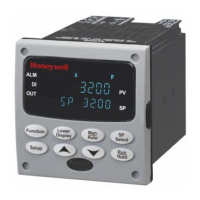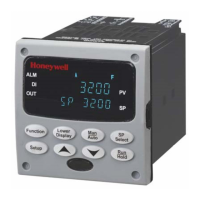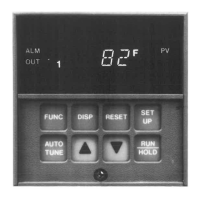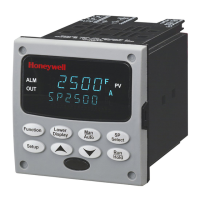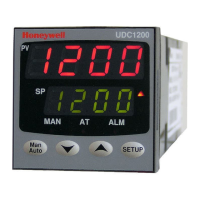Setpoint Rate/Ramp/Soak Program Operation
80 UDC3300 Expanded Model: DC330E User Manual 5/00
4.17 Carbon Potential
A carbon probe consisting of a ZrO2 sensor and a thermocouple (to measure the
temperature at the sensor) provides two inputs to the controller. The controller
computes the atmosphere’s actual carbon potential from these two inputs and
compares the computed value with the desired setpoint. An on-off or PID control
algorithm determines the controller output necessary to keep the actual carbon
potential at the setpoint. Usually only one output is used to add more or less
enriching gas (typically natural gas) to the furnace’s base atmosphere, which has a
relatively low carbon potential.
The enriching gas then raises the carbon potential to the desired level; however,
there are occasions when it is necessary to add dilution air to lower the carbon
potential instead of enriching gas to raise it. In those instances, a second output
from the controller provides this function. When proportional control is used, a
different set of PID tuning constants is used for the dilution air than those used for
the enriching gas.
T/C
f(x) f(x)
PID
E/P
CV
Carbon
Probe
O
2
Sensor
Carburizing
Furnace
%
Carbon
PV
%
Carbon
Calc.
Output
Enrichment Gas
• SP
• 2SP
• 3SP or
RSP
Input 2 Input 1
UDC 3300
24185
millivolts
CP
Input 3—
Optional Online
CO Compensation
Figure 4-3 UDC 3300 Controller Being Used to Control the Carbon Potential of a
Furnace’s Atmosphere
The following rules apply for Carbon Potential control
• For Carbon control, set Input Algorithm 1 to the proper carbon sensor used and
set the PV source to IN AL 1. Input 1 will automatically become CARBON.
• For % Oxygen control, set Input Algorithm 1 to OXYGEN. Input 1 will
automatically become OXYGEN.
• For Dewpoint control, set Input Algorithm 1 or Input Algorithm 2 to DEW PT.
Input 1 will automatically become CARBON. The availability of Dewpoint on Input
Algorithm 2 provides the capability of controlling Carbon Potential on Loop 1 and
also reading the Dewpoint value from the same probe.
• CO Compensation—Receives external CO transmitter signal via Input 3 to
provide online compensation of the carbon calculation. Requires that the Input 2
temperature signal be a transmitter type input.

